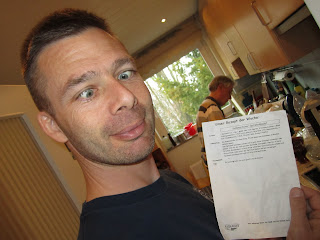Last night, Ulla and Manfred invited us over for a traditional Swiss "Raclette." We just love Ulla and Manfred. They are 73 and 72 years old respectfully, and are like our grandparents here in Germany. Ulla is my German teacher; we met at my German school.
We started off the afternoon with a traditional "Kaffee und Kuchen" or coffee and cake (in this case, homemade orange cake with real orange rinds and squeezed orange and lemon inside. Yum.)
The weather was gorgeous so we sat on the balcony. We then headed out for a fun walk to feed the wild boars at a local forest. That was so much fun!
The weather was gorgeous so we sat on the balcony. We then headed out for a fun walk to feed the wild boars at a local forest. That was so much fun!
"This little piggie went to market..."
We then headed back to the apartment, where Zev tried to read the recipe for one of the dishes in German:
Here is some info on a traditional Swiss raclette, courtesy of Wikipedia:
Here is some info on a traditional Swiss raclette, courtesy of Wikipedia:
Raclette is a dish indigenous to parts of Switzerland. The Raclette cheese round is heated, either in front of a fire or by a special machine, then scraped onto diners' plates; the term raclette derives from the French word racler, meaning "to scrape". Traditionally, it is accompanied by small firm potatoes (Bintje, Charlotte or Raclette varieties), gherkins, pickled onions, and dried meat, such as prosciutto and viande des Grisons.
In the Swiss canton of Valais, raclette is typically served with tea or other warm beverages. Another popular option is to serve raclette with white wine, such as the traditional Savoie wine or Fendant, but Riesling and Pinot Gris are also common.
Raclette was mentioned in medieval writings as a particularly nutritious meal consumed by peasants in mountainous Switzerland. It was then known in the German-speaking part of Switzerland as Bratchäs, or "roasted cheese."
Traditionally, the Swiss cow herders used to take the cheese with them when they were moving cows to or from the pastures up in the mountains.
In the evenings around the campfire, they would place the cheese next to the fire and, when it had reached the perfect softness, scrape it on top of some bread.
Traditionally, the Swiss cow herders used to take the cheese with them when they were moving cows to or from the pastures up in the mountains.
In the evenings around the campfire, they would place the cheese next to the fire and, when it had reached the perfect softness, scrape it on top of some bread.
A modern electric Raclette grill and various accompanying foods. A modern way of serving raclette involves an electric table-top grill with small pans, known as coupelles, to heat slices of raclette cheese in. Generally the grill is surmounted by a hot plate or griddle. The cheese is brought to the table sliced, accompanied by platters of boiled or steamed potatoes, other vegetables and charcuterie. These are then mixed with potatoes and topped with cheese in the small, wedge-shaped coupelles that are placed under the grill to melt and brown the cheese. Alternatively, slices of cheese may be melted and simply poured over food on the plate. The accent in raclette dining is on relaxed and sociable eating and drinking, the meal often running to several hours. French and other European supermarkets generally stock both the grill apparatus and ready-sliced cheese and charcuterie selections, especially around Christmas. Restaurants also provide raclette evenings for parties of diners.
We had such an enjoyable evening and ate so much that our bellies hurt when we got home.
Wishing you a wonderful week! Love Zev and Fifi xoxo
















No comments:
Post a Comment